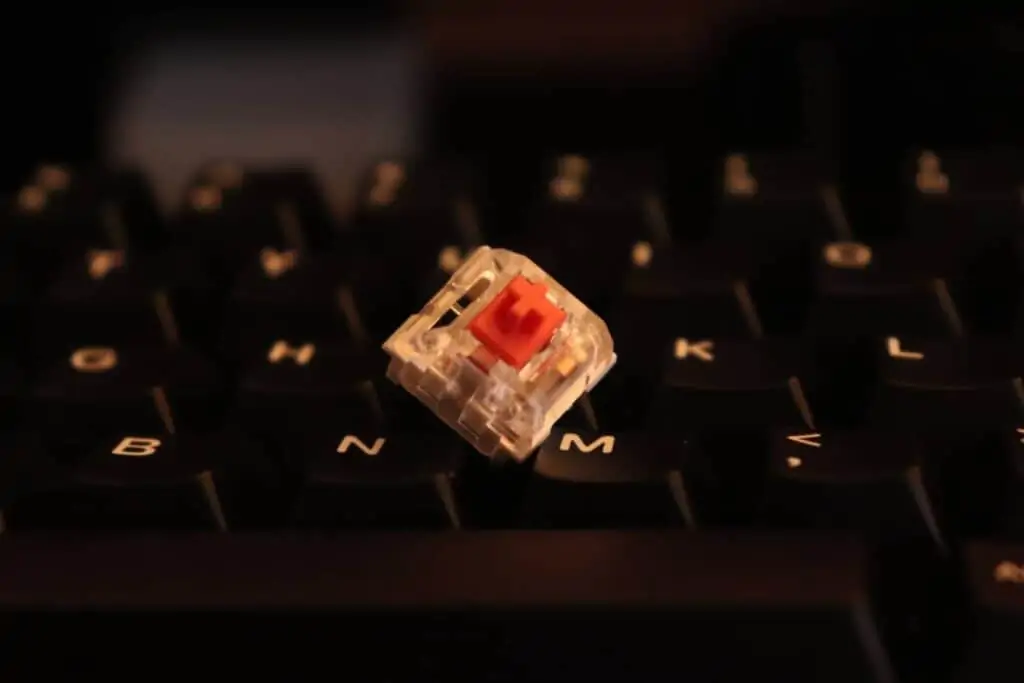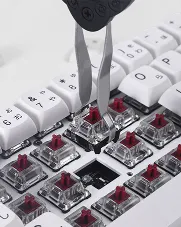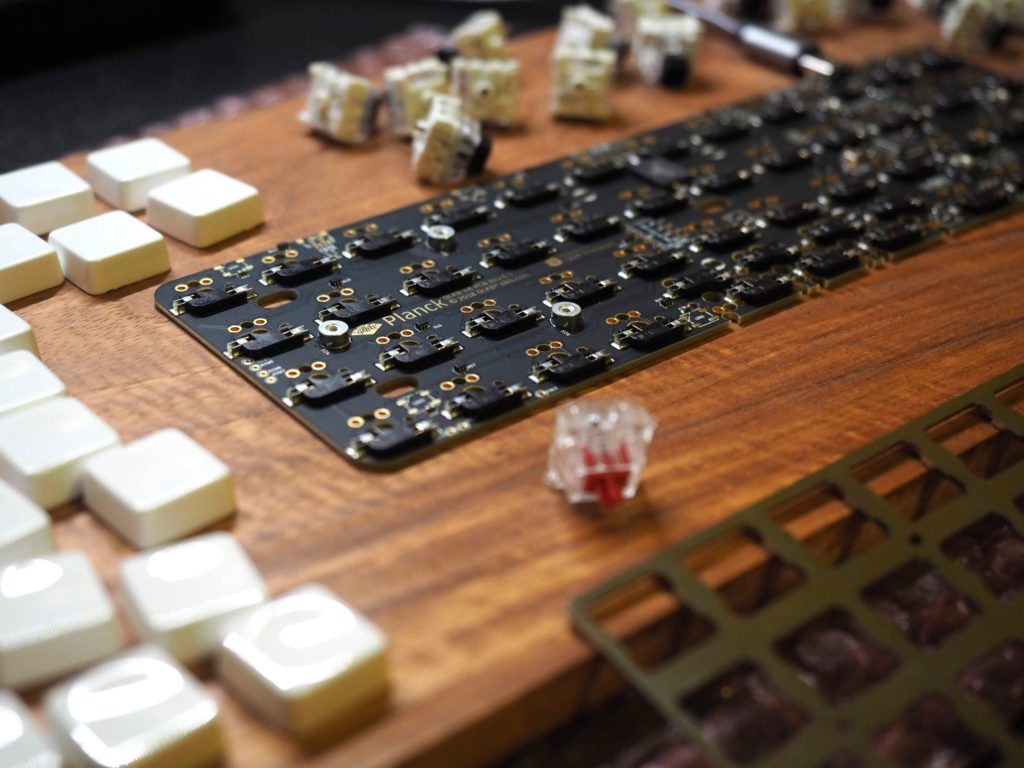If you’ve ever wondered what makes mechanical keyboards so special or how to choose the ideal switch for your typing needs, this guide is for you.
To begin, we’ll take a closer look at the types of switches and their differences. We will then look at the anatomy of a mechanical switch and the different types of components. After that we will discuss common terms you’ll come across when looking for a switch. Finally, we will look at the things you need to look at before buying a switch, and the most popular switches in the market right now.
What are switches?
Switches are the mechanisms under keycaps that enable the user to type faster and more precisely. Switches register every press of a key, and allow you to customize the feel, sound, and smoothness of your keycaps.
There are six different types of mechanical switches:
Linear switches
Linear switches offer a smooth and silent keypress with no bumps, the only factor that affects how a linear switch feels is the size and weight of the spring underneath.
Clicky Switches
Clicky switches give a sharp click sound along with a tactile bump when a key is pressed, many typists find that click sound satisfying which is why clicky switches are popular.
There are two types of clicky switches:
- A click jacket switch is the more traditional clicky switch. The click sound comes from the two-part stem which is called the click jacket.
- A click bar switch produces a click sound when the key is pressed and produces another one on return. This switch does not rely on the stem or leaf of the keycap, it instead uses a horizontal leg over a metal bar. You can get click bar switches in three sizes: Thin, Midsized, and Thick.
Tactile Switches
A tactile switch has a bump you feel when pressing it. The tactility of a switch is affected by bump shape, bump size, bump position, spring weight, and bump strength.
Pretravel refers to the distance traveled before the tactile bump is felt.
The bump shape is determined by the shape and curve of the stem legs. An angled stem feels sharper, while a curved stem feels more rounded and smooth.
A P Bump will have a moderately sized bump while a D Bump will have a larger noticeable bump.
Bump Strength is defined as how much resistance is felt in the keypress. This is determined by the shape of the contact leaf of your switch.
Bump Position refers to the point where the switch actuates or produces tactile feedback. In a tactile switch with no pretravel, the bump is located at the top of the key, and resistance is felt immediately.
Many Tactile switches have a range for spring weight, and if the weight is above or below this weight the switch will feel less stable and less tactile.
Silent Switches
A silent switch provides you with a small thud and soft keypress. This is possible with the use of silicon dampening pads, which are placed on the stem of the switch. These greatly reduce the click sound of the switch. Silent switches are available in both linear and tactile forms.
Speed Switches
By shortening the distance it takes for your keypress to register, Silent switches make our keypress twice as fast. These are ideal for gamers and typists who need more keystrokes per minute.
Kailh Box Switches
These switches are a unique design of the popular Cherry MX switches. They have a unique box design that houses all the important components in it to protect them from dust and water. This greatly increases the longevity of the switch and the design also reduces the wobbliness of keys when typing.
Related: Fastest Keyboard Switches
Other types of keyboard switches
This guide features MX-style switches, but there are a lot more switches that can be used in a keyboard. Each switch is different and has a unique feature that may be useful to people with different preferences.
Optical Switches
Optical switches are a new technology that has been gaining popularity in recent years. These are contactless switches, which means that they do not rely on metal pins or leaves to actuate. These switches have a longer lifespan than mechanical switches, and they are faster and smoother as well. However, they do not have the customization options you can get in a mechanical switch and they cannot be modded either.
Alps/Matias Alps Switches
These switches are mostly found in vintage keyboards, and their most popular switch series are the SKCM line. Alps switches have a different feel and tactility than mechanical switches and are preferred by many people over mechanical switches. These switches are no longer being made, but their clones are being modded and sold by a company called Matias.
Now that we have gone over the different types of switches, we will go over the different parts of a switch.
Stem
The stem is part of the switch that moves vertically when pressed, transmitting the keystroke to the computer or device. It consists of a plastic plunger that houses the keycap and a stem slider that connects to the switch’s electrical contacts. The stem design can vary depending on the specific mechanical switch type, each with its own unique stem shape and characteristics.
Spring
The spring is the component of a mechanical switch that is responsible for providing resistance and returning the keycap to its original position after it’s been pressed. The characteristics of a spring, such as its material, thickness, and coil design, directly impact the typing experience and overall feel of the switch. Different springs can provide varying levels of resistance, which affects the force required to actuate and bottom out a key.
There are generally three types of springs used in mechanical switches:
- Linear Springs: These springs provide a consistent force throughout the key press. They have a constant resistance from the moment a key is pressed until it reaches the bottom.
- Tactile Springs: These springs provide tactile feedback during the key press, indicating a distinct actuation point. They have a bump you feel when pressing the key, providing feedback to you.
- Clicky Springs: Clicky springs provide both tactile feedback and an audible click sound. They have a mechanism that produces an audible click when the key is pressed in addition to tactile feedback.
Top Housing
The top housing of a mechanical switch refers to the upper part of the switch housing that surrounds the stem and keycap. The top housing serves several purposes in a mechanical switch such as:
- Keycap Mounting: The top housing provides a stable platform for mounting the keycap. It has a keycap mount that aligns with the stem of the switch, allowing the keycap to be securely attached.
- Stem Guide: The top housing guides the stem’s verticle movement during the key press. It ensures that the stem moves smoothly and vertically within the switch, preventing any lateral movement or wobbling.
Bottom Housing
The bottom housing of a mechanical switch is the lower part of the switch housing that contains all the electrical contacts and provides stability to the switch assembly. The functions which the bottom housing serves in a mechanical switch are:
- Electrical Contact Enclosure: The bottom housing contains the electrical contacts of the switch. These contacts are registering the keystrokes when the switch is actuated. The bottom housing ensures that these contacts are properly enclosed and protected.
- Switch Stability: The bottom housing provides stability to the switch assembly by holding the internal components, such as the spring and sem, securely in place.
Leaf
The leaf is a small metal component that is part of the switch’s internal structure. It is responsible for creating a connection between the switch’s electrical contacts when the key is pressed.
The Leaf is usually made of thin metal, such as stainless steel or copper. It is positioned inside the switch housing, beneath the stem, and above the electrical contacts. When the stem is pressed down, the leaf is flexed or bent, allowing the metal contacts at the leaf to come into contact with each other, closing the electrical circuit.
The leaf plays an important role in determining the switch’s behavior, including its actuation force and tactile feedback. Different types of leaves can provide varying levels of tactile feedback.
Switch Plastics
Mechanical Switches utilize different types of plastics in their construction, each with different characteristics and properties. Most switches use a variety of plastics in their components, here is a brief overview of some commonly used plastics:
Polycarbonate: Polycarbonate is a durable and transparent thermoplastic. It is known for its high impact resistance, making it suitable for switches that require robustness. Polycarbonate is often used in top housings, it is not used in bottom housings because it has a low melting point. This plastic is smoother than nylon, and RGB lighting effects look the best on Polycarbonate switches.
Nylon: This plastic is a common choice for mechanical switch components due to its strength, durability, and favorable frictional properties. Nylon is often used in switch components such as stems and housings. It offers good resistance to wear, abrasion, and chemicals. It has a smooth surface and can contribute to a smooth keystroke experience.
Polyoxymethylene(POM): POM, also known as Delrin, is a low-friction thermoplastic commonly used in mechanical switches. POM has excellent mechanical properties, such as high stiffness and low friction. It is commonly used in stems and housing components because of its durability and abrasion resistance.
The following are some terms and words that are used when describing a switch:
Actuation Point: In simple terms, the actuation point is associated with the distance a key needs to travel when it is pressed for it to be registered as a keystroke. The actuation point is the specific point in the key’s travel where an electrical contact is made or broken, resulting in the activation or deactivation of a switch.
The actuation point is typically measured in millimeters(mm) or sometimes in grams of force required to trigger the switch.
Travel Distance: The travel distance is the distance a key travels when pressed and released.
Keyboards with mechanical switches usually have a travel distance that ranges from 2mm to 4mm.
Spring Weight: The spring weight refers to the amount of force required to depress and release the switch. It determines the resistance felt when pressing a key on a mechanical keyboard.
Spring weight in mechanical switches is measured in grams(g) or centinewtons(cN). The higher the spring weight, the more force is needed to actuate the switch.
Pretravel: It is the distance a keycap must be pressed downward before the actuation point of a mechanical switch is reached.
These are some things to look out for when buying a switch:
3-Pin and 5-Pin Switches
One of the main differences between 3-pin and 5-pin switches is their stability when mounted on a PCB. 5-pin switches provide greater stability due to the two extra plastic pins on the switch housing, these additional pins fit into the corresponding holes in the PCB, preventing the switch from wobbling or becoming loose.
3-pin switches are designed to fit directly into the three solder points for each switch. They do not have additional pins and rely on the soldered joints to secure them to the PCB. 5-pin switches are compatible with both PCBs that support 3-pin switches and those that have extra holes to accommodate the extra pins. This allows 5-pin switches to be used in a wider range of PCBs.
Type of switch housing
There are two commonly used switch housings in mechanical switches. They are MX Style switch housings and Winglatch housings.
MX Housings are primarily associated with Cherry MX switches, their housing design has been adopted by various switch manufacturers. These housings have a cross-shaped stem, with a leaf springed design. They are compatible with a wide range of keycaps, and many third-party keycap manufacturers specially design their keycaps to fit MX stems, making it easy to find compatible options.
Winglatch housings have a rectangular-shaped stem which increases stability and reduces wobbling. One of the more notable advantages of Winglatch housings is their improved resistance to water and dust, which help prolong the switch’s lifespan. While Winglatch housings are compatible with some keycap sets designed for MX switches, the rectangular stem shape does not fit all keycaps perfectly.
Switch Brands and Manufacturers
Cherry MX
Cherry MX switches are considered the gold standard in the mechanical keyboard world. They are known for their smooth operation, durability, and variety of switch options.
Gateron
Gateron switches have gained popularity for providing a similar feel as Cherry MX switches but at a more affordable price point. They offer a range of switch options and are known for their smoothness and consistent performance.
Kailh
Also known as Kaihua, Kailh switches have made a name for themselves with their diverse range of switch options, including their popular box switches. They also produce hot-swap sockets and mouse switches as well, and their switches are known for their durability and unique features like dust and water resistance.
Outemu
Outemu switches are recognized for their affordability while still offering decent performance. They come in various switch types and are found in budget-friendly mechanical keyboards.
ZealPC
ZealPC is known for its high-end premium switches that are designed with great attention to detail. They offer some of the best tactile and silent tactile switches available and are often praised for their premium build quality and smoothness.
Final Words on Keyboard Switches
Because of all the possible information about mechanical switches, this article may never be complete. We will continue to update this article with links and more helpful information.
Thank You for reading.


